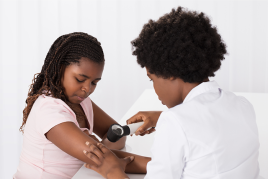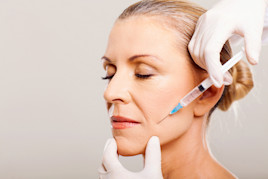Skin cancer types: Melanoma causes
What causes melanoma?
Research indicates that ultraviolet (UV) light from the sun and indoor tanning can:
Cause melanoma
Increase the risk of a normal mole turning into melanoma
How can UV light cause skin cancer?
UV light is a known carcinogen (cancer-causing substance). Every time UV light hits our skin, it can damage some of the DNA inside. The body tries to repair this damage.
When the damage becomes more than the body can repair, changes (mutations) develop in our skin’s cells. As the mutations build up, skin cancer can develop.
The type of skin cancer a person gets depends on which cells have mutations. Melanoma develops when mutations develop inside cells called melanocytes (meh-lan-oh-cites). These cells give skin its color.
How often do you protect your skin from the sun?
Spending time outside without protecting your skin from the sun increases your risk of getting melanoma.

Do some people have a higher risk of developing melanoma?
Yes, you have a higher risk of getting melanoma if you:
Spend time outdoors without protecting your skin from the sun. To protect your skin from the sun, dermatologists encourage everyone to wear sun-protective clothing, such as a wide-brimmed hat, long sleeves, and pants whenever possible.
Use tanning beds or other indoor tanning equipment. The UV light from these tends to be stronger than those from the sun. Not using these can reduce your risk of getting all types of skin cancer.
Have had blistering sunburns. A sunburn means UV light has badly damaged your skin.
Have fair skin, light-colored eyes, or naturally red or blond hair. Your skin is more easily damaged by UV light if you have one or more of the following:
Have celebrated your 50th birthday. Being 50 or older increases your risk of developing melanoma; however, some people develop melanoma earlier.
Have certain moles. Most moles are harmless, but you have a higher risk of getting melanoma if you have:
Have a weakened immune system. Anything that weakens your immune system increases your risk of developing melanoma. Some medications, such as drugs taken to prevent your body from rejecting a transplanted organ weaken the immune system. Some medical conditions, such as HIV, also weaken the body’s immune system.
Sun protection crucial for organ transplant recipients
If you have received an organ transplant, you have a higher risk of developing melanoma and other skin cancers.

Have had melanoma or another skin cancer. If you’ve had melanoma or another type of skin cancer, your skin has been badly damaged by UV light. This increases your risk of developing more skin cancers, including melanoma.
Have had breast or thyroid cancer. A few other cancers aside from skin cancer can increase your risk of developing melanoma. These include breast and thyroid cancers.
Have one or more blood relative who has (or had) melanoma. Although rare, melanoma can run in a family. When this happens, some people inherit genes for melanoma. Melanoma may run in your family if close blood relatives have had this skin cancer.
Have xeroderma pigmentosum. This is an extremely rare condition, which makes a person’s skin unable to repair any damage caused by UV light. Because the body cannot repair any UV damage, it’s estimated that XP can raise the risk of getting skin cancer 10,000-fold.
Who gets melanoma?
While some people have a higher risk of developing melanoma, it’s important to know that melanoma develops in people of all skin colors from the palest to the darkest.
When melanoma develops in a person who has skin of color, the cancer often begins on the bottom of the foot, palm of the hand, or beneath (or around) a nail. UV light isn’t believed to play a role in these melanomas.
That’s why it’s essential for everyone to:
Check their skin for signs of melanoma
See a board-certified dermatologist if a spot on your skin looks like it could be melanoma
While you can find a spot on your skin that could be melanoma, you cannot know for sure whether that spot is melanoma. To find out how it’s diagnosed, go to: Melanoma: Diagnosis and treatment.
Images
References
National Comprehensive Cancer Network. “NCCN guidelines for patients: Melanoma.” 2018. Last accessed February 12, 2019.
 Molluscum contagiosum: How to safely treat it
Molluscum contagiosum: How to safely treat it
 Biosimilars: 14 FAQs
Biosimilars: 14 FAQs
 Practice Safe Sun
Practice Safe Sun
 Relieve uncontrollably itchy skin
Relieve uncontrollably itchy skin
 Fade dark spots
Fade dark spots
 Untreatable razor bumps or acne?
Untreatable razor bumps or acne?
 Laser hair removal
Laser hair removal
 Scar treatment
Scar treatment
 Botox
Botox
 Free materials to help raise skin cancer awareness
Free materials to help raise skin cancer awareness
 Dermatologist-approved lesson plans, activities you can use
Dermatologist-approved lesson plans, activities you can use
 Find a Dermatologist
Find a Dermatologist
 What is a dermatologist?
What is a dermatologist?